Motorola Motoluxe Review
Motorola Motoluxe
With a 4in screen and 8MP camera this is a surprisingly capable budget Android smartphone.
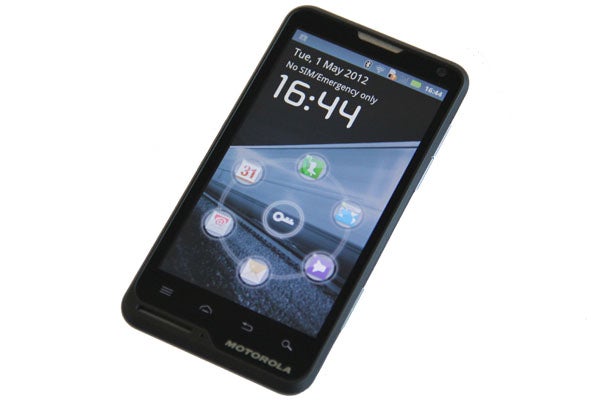
Verdict
Pros
- Smart design and good build quality
- Large and high-res screen for its price
- 8MP camera with dedicated button
Cons
- Too sluggish in general use
- Camera not as good as you'd hope
- Interface is fine but nothing special
Key Specifications
- Review Price: £190.00
- 4in FWVGA 480x854 screen
- Android 2.3.7
- Notification light
- 8 MP camera with auto-focus
Watch our video review of the Motorola Motoluxe:
Hardware and Design
The Motoluxe has a quirky design. For the most part it’s just another black slab with a big-ol screen on the front and a soft touch black finish on the back. But the little step in the section below the screen and the silver grill under the slide-off back panel set it apart. We rather like the look though we could easily see how some people would find it a bit fiddly looking.
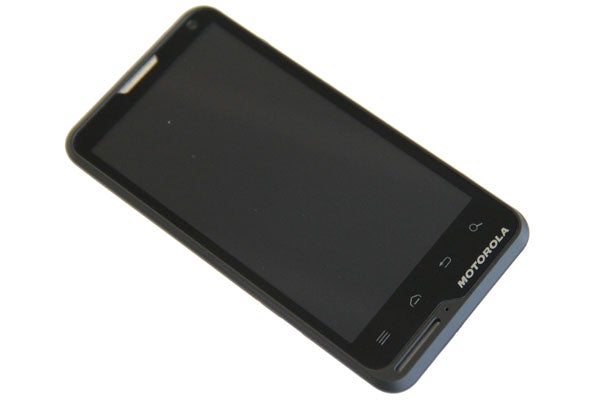
Less subjective is how it feels to use. Its mid-size dimensions of 117.7 x 60.5 x 9.9 mm mean it sits nice and snug in the hand, unlike some of these much larger models. It’s easy to reach the full expanse of the screen and all the phone’s buttons, without having to shift your grip too much or use two hands. In fact, this is actually a slightly smaller phone than the excellent HTC One V, yet it houses a larger screen. It’s also relatively slim and light, and the soft-touch is both grippy and comfortable to grip.
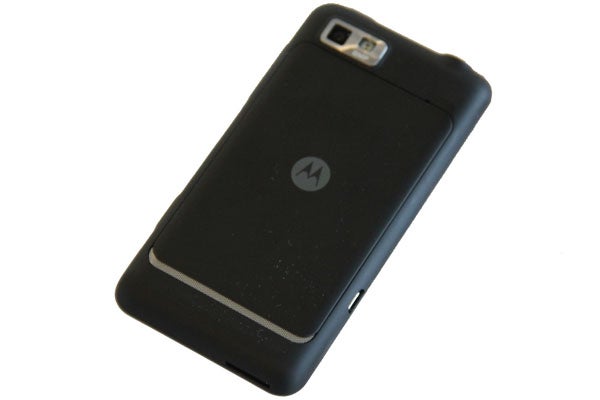
Probably the most obvious feature of this phone is that step at the bottom, which serves a couple of purposes; you can use it as a loop for a strap or lanyard and embedded within it is a light. This light glows red/yellow/green when the phone’s charging and flashes blue/green/purple if the phone receives an email, text or voicemail. It’s a nice addition in practical terms though we do wonder if it’s a little oversized and bright – it’s certainly not subtle. The same could be said of the Motorola logo alongside.
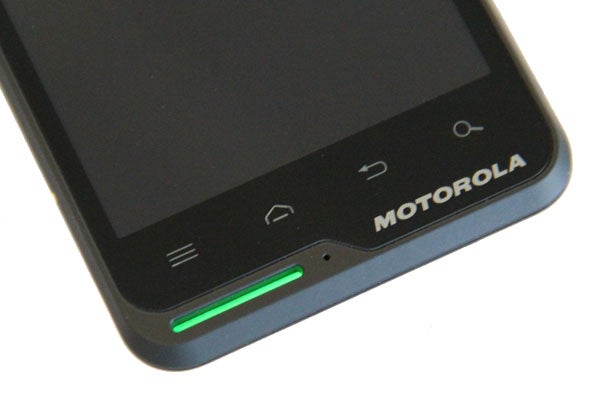
In something of a throwback, the front navigation buttons include a dedicated one for Search. Not only does Android 4.0 do away with the search button as standard but even many older Android handsets from other manufacturers had dropped this. It’s somewhat by the by but we’d certainly not mourned the loss of this button and aren’t particularly pleased to see it here. Otherwise the backlit touch-sensitive buttons are responsive and easy to use.


Round the rest of the handset we’ve got a headphone jack and power button on the top edge, volume rocker and dedicated camera button on the right, microUSB (MHL) port on the left, and the camera on the back. Under the battery cover you’ll find the 1420mAh battery, SIM slot and microSD card reader. The phone comes with just 1GB of internal memory so a card is a must. Thankfully it supports ones up to 32GB
It’s great to see a removable battery cover on the back, but it is a little bit too removable. On a couple of occasions we knocked the phone from a coffee table and sofa onto the carpet and the panel pinged off. Clearly one shouldn’t drop a phone if you can help it but these things happen and it was a little irritating to have to reattach the back every time.
Screen
The Motorola Motoluxe’s screen clearly isn’t the most dazzling ever created but it’s still very much up to the job. At 4in, it’s slightly bigger than that of most mid-range handsets, and its 480 x 854 pixel resolution is slightly higher too. The two combine to make it a comfortable size to use and plenty sharp enough too. It’s also notable just how little bezel there is round the top and sides of the phone, making it both look more premium and helping keep the phone smaller than the HTC One V.
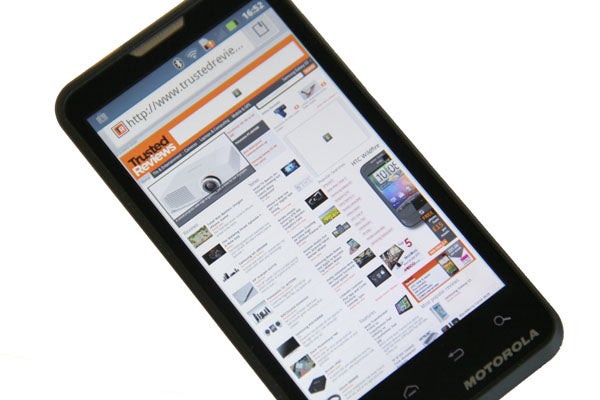
Where it falls down slightly is its viewing angles and colour reproduction. It’s an LCD panel so has accurate looking colours but it doesn’t have the pop of AMOLED or the best LCDs, and it looks a little washed out. As for viewing angles, colours loose even more of their impact when viewed from much of an angle. Overall brightness isn’t ground breasking either. It’s still a vast improvement over equivalents from last year but noticeably trails the current best too.
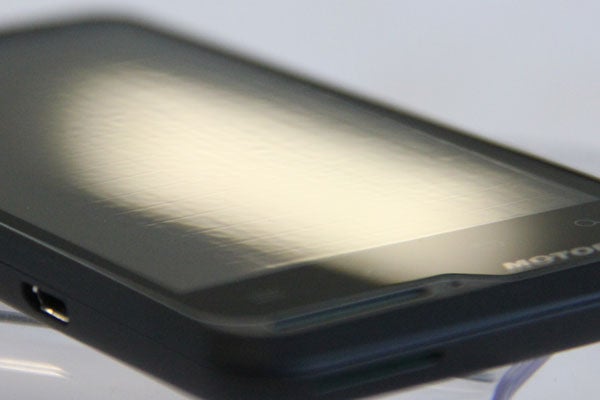
Less of a genuine everyday concern but still notable is the pattern that’s visible right across the surface of the screen. Something to do with the touch sensing layers this grid could be a little distracting if watching a video, for instance.
Performance
Far more of a concern than the Motorola Motoluxe’s screen is its performance. With only an 800MHz Qualcomm MSM7227A-0 beating at its heart – there’s no two ways about it – it feels sluggish. Where the HTC One V felt simply not as fast as its high-end contemporaries, the Motoluxe is another step down.
Not helping matters is the phone’s use of Android 2.3.7 (Gingerbread) rather than the newer 4.0 iteration. Android 4.0 uses the graphics chip properly to smooth out the interface whereas previous iterations relied on the CPU. The result is that the interface stutters rather than glides. Again comparing to the One V, even it managed to feel smooth, with you merely having to wait that bit longer for an app to load when compared to high-end handsets. Here though, you’re regularly greeted by a laggy look. According to Motorola’s website the Motoluxe is in the ‘Evaluation and planning’ stage for getting a 4.0 update, which judging on past form would suggest an update will be a few months away.
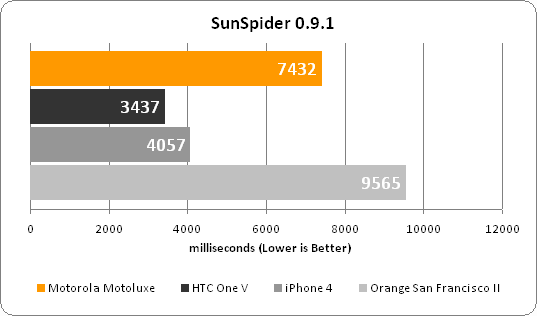
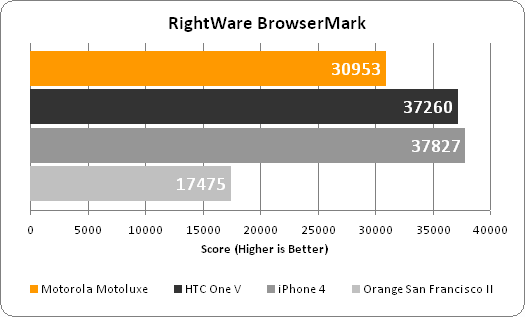
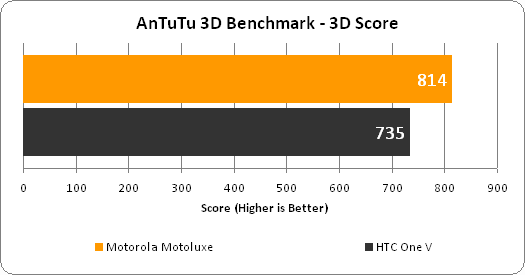
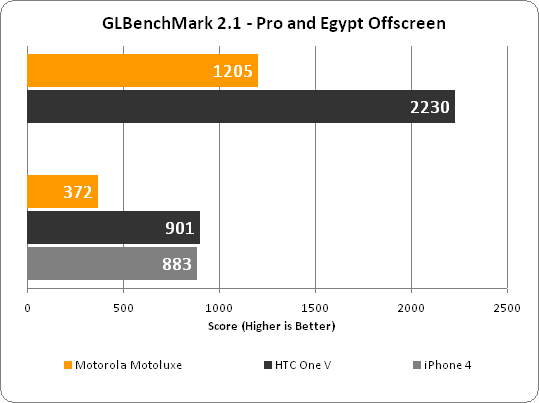
Backing up our subjective findings were our benchmarks. In the web browser based benchmarks, SunSpider and BrowserMark the Motoluxe trails the likes of the iPhone 4 and HTC One V by some distance, though it beats the likes of the super-budget Orange San Francisco 2. Likewise when it comes to gaming, this is no powerhouse, though most basic puzzler titles such as Angry Birds and Where’s My Water? should work.
Interface
The interface itself is… okay. Ultimately it’s Android so does all the requisite basics as well as you’d expect. Calling, contacts management, texting, email and web browsing are all easy enough to do, so long as you have a little patience.
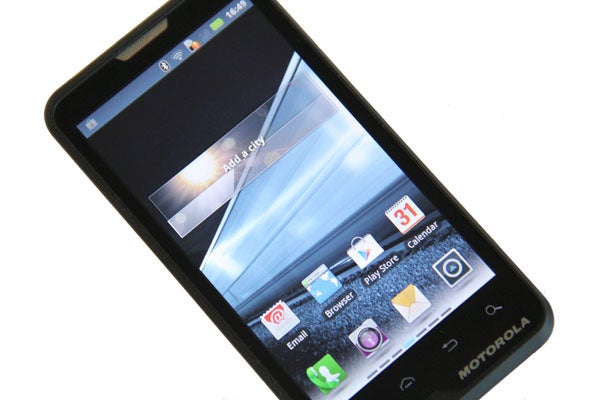
Unlike some previous Motorola handsets, the company hasn’t tweaked things too much, though it has had a bit of a rummage. Possibly the first features you’ll notice are a couple of widgets. Both of a similar visual style, they highlight your most oft used apps and contacts, arranging them in a smallest to biggest spiral of icons. They’re a neat application of the idea of widgets; giving you instant access to something that would otherwise require taking a few steps within an app. That said, we didn’t find ourselves using them.
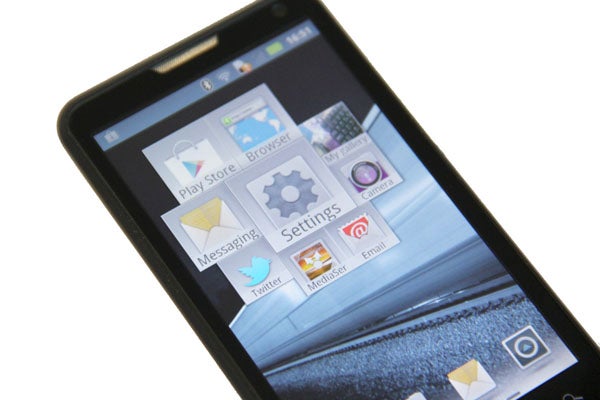
Another tweak is the lock screen. As with a number of other Androids, you can drag the key to unlock straight to the homescreen or pull an icon onto the key to open the phone to that app. It’s a useful addition though we couldn’t work out how to customise it, and found the default selection not quite to our liking – no camera?!

Something definitely not to our liking is the zoomed out homescreen view. Like the HTC range, if you tap the home button when already on the homescreen, you’re zoomed out to a grid of thumbnails showing all the seven homescreens. We’ve never found it useful and it’s particularly irritating here as the sluggishness of the phone means you often aren’t sure if you’ve pressed the home button or not, so end up pressing twice then shooting to this view rather than the main homescreen.

Elsewhere there are minor tweaks to the keyboard and contacts but there’s nothing out of the ordinary here. The phone will automatically link up your contacts in Gmail/email, Facebook and Twitter but it won’t pull in information from these services into the contact page like on some phones – it just provides links to the apps. Speaking of Twitter, we had constant problems with it crashing once we’d input our details. We couldn’t get to the bottom of it in our time with the phone.
Multimedia
Given this phone’s performance, it’s no surprise it isn’t a total multimedia powerhouse. In particular video playback is very limited with HD files not playing ball. Browsing your photos and listening to music is a cinch, though. We would’ve liked to see easier access to music controls – say from the lockscreen – but we got by. It’s also easy to get your files on the phone, with you not needing to install any software before being able to just drag and drop your files on.
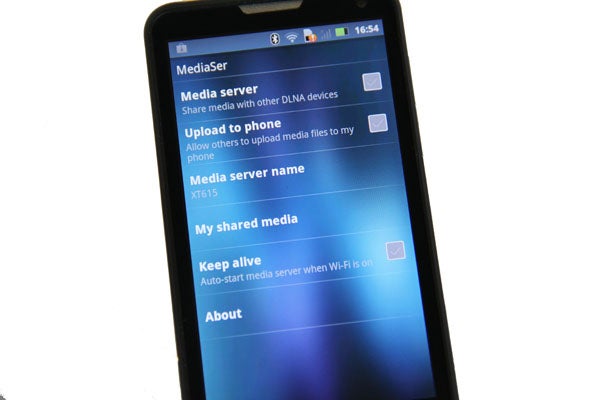
The MHL capable microUSB socket means you can hook the phone up to a TV’s HDMI input with the help of a compatible cable and either browse your phone or watch video on the big screen, though again the mediocre video performance will limit the occasions where this is worthwhile.
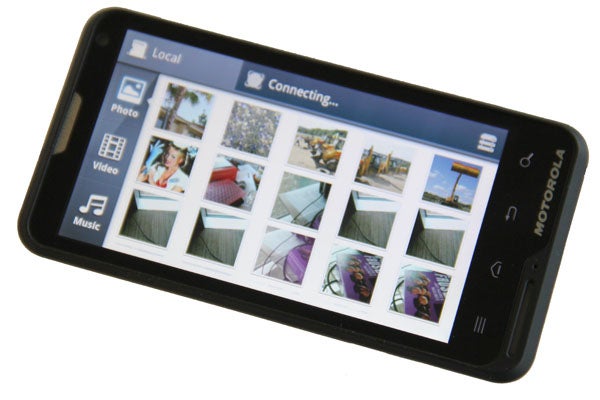
If you prefer the wireless route, the MediaSer and MediaSee apps come in useful. The former lets you share your phone’s media with any DLNA compatible devices – i.e. a TV – while the latter will lets you play content from a DLNA server on your phone.
Camera
Motorola is definitely onto something, in adding a high-spec camera to a mid-range handset, but the headline-grabbing 8MP model here doesn’t actually deliver the goods.
Starting with the good stuff, though, the presence of a proper button is great to see. Hold this down and it’ll launch the camera app, half press it and it’ll focus and a full press will take the snap. Performance of the app is also surprisingly good while overall detail level is reasonable too and the single LED flash does a reasonable job.
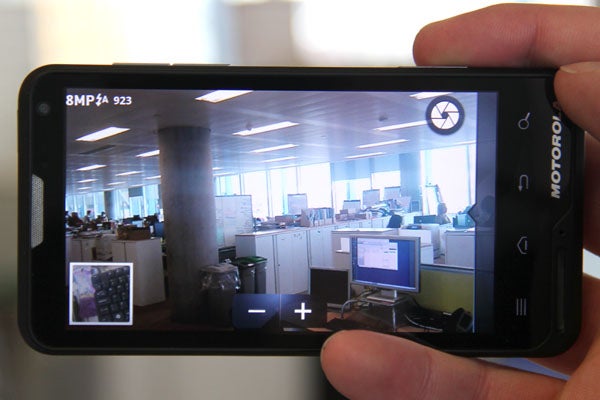
However, the app isn’t very easy to use. A lot of features are hidden away from view and it can take some time to pick out the scene modes or effects you want. Worse is that you can’t touch on the screen to pick a focus point. Without this feature it’s difficult to pinpoint exactly what you want the camera to highlight.
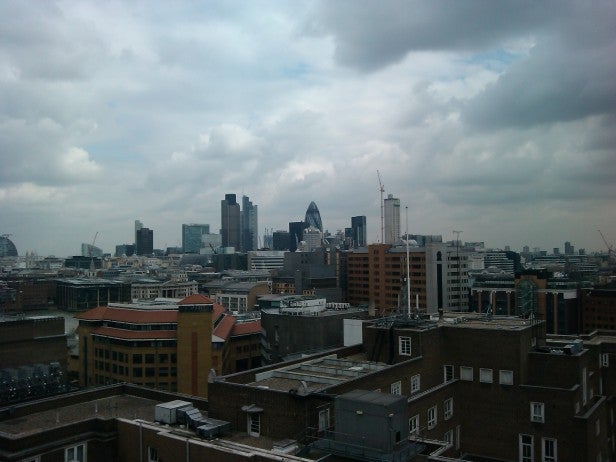
Overall detail from your shots is okay but there’s nothing outstanding here. Overall we’d say the iPhone 4’s 5MP snapper easily gives it a run for its money.

As for video, only a max resolution of 800 x 480 (WVGA) and frame rate of 24fps is on offer so we’re not talking Avatar levels of fidelity but it’ll get you by.
In another surprise for a mid-range handset, you get a front facing camera too. As ever quality is only of video chat level but then that’s all it’s meant for.
Battery and Calling
The Motorola Motoluxe’s call quality is surprisingly good all other things considered. The microphone is noise cancelling and the earpiece is clear and reasonably loud. The speaker’s not all that great but is on par, as is reception.
More impressive is battery life. With only modest hardware onboard, and a still reasonable size battery we easily found this phone would last a day and a half or more of regular use, while it dropped an imperceptible amount of battery left in standby (and Airplane mode, it must be noted) over a weekend.
Verdict
We’re split on the Motorola Motoluxe. On the one hand it offers good build quality, design, screen and camera for its price but on the other, its performance is borderline not good enough. We hesitate to say it’s outright too slow but we definitely found ourselves getting frustrated as we waited for apps to load or the interface to respond. We’d forgave this level of performance in the Motorola Defy as it offered ruggedness and waterproofing as a sweetener, but it feels more acutely lacking here. Were this phone running the same processor as the HTC One V it would be a much closer call but as it is we’d either grab the One V or think long and hard about whether to pick up a second hand premium model from last year instead.
How we test phones
We test every mobile phone we review thoroughly. We use industry standard tests to compare features properly and we use the phone as our main device over the review period. We’ll always tell you what we find and we never, ever, accept money to review a product.
Trusted Score
Score in detail
-
Performance 5
-
Camera 7
-
Design 8
-
Usability 7
-
Value 7
-
Features 7
-
Screen Quality 7
General
| Operating System | Android OS |
| Height (Millimeter) | 117.7mm |
| Width (Millimeter) | 60.5mm |
| Depth (Millimeter) | 9.9mm |
| Weight (Gram) | 123.6g |
| Available Colours | Black |
Display
| Screen Size (inches) (Inch) | 4in |
| Screen Resolution | 480 x 800 |
| Touchscreen | Yes |
Battery
| Talk Time (Minute) | 270m |
| Standby Time (Hour) | 400hr |
Storage
| Internal Storage (Gigabyte) | 1GB |
| Expandable memory | MicroSD up to 32GB |
| Camera (Megapixel) | 8 Megapixel |
| Front Facing Camera (Megapixel) | Yes Megapixel |
| Camera Flash | 1 x LED |
Connectivity
| Bluetooth | Yes |
| WiFi | Yes |
| 3G/4G | Yes |
| 3.5mm Headphone Jack | Yes |
| Charging/Computer Connection | microUSB (MHL) |
Processor and Internal Specs
| CPU | 800MHz Qualcomm MSM7227A-0 |
Misc
| App Store | 450,000+ apps |
| GPS | Yes |

